
Admin Notes
by Dr. Gwyn Underwood, Superintendent
For those who may have been wondering, the compensatory holiday this past Monday was scheduled to facilitate the kick-off to our annual Professional Learning Weekend for faculty. Our CIS Core Beliefs states Learning is a joyful, creative, and open-ended exploration, and this extends to our faculty as well, where we are constantly seeking new ways of doing things, just like our students!
How can we learn to get on better?
We live in a divided world. Just consider different countries, organizations, groups of people, and even some families and you will know what I am referring to. It is evident that getting on with each other is a challenge for us humans at all levels of society. We can blame competing politics, philosophies, religions, cultures, beliefs, and so on – but, what if all of these are just the products of the problem? What would the problem itself be?
I will leave you to dwell on your answer to that for now and focus on options we have to learn how to deal with differences more effectively than we have collectively been doing. Actually, the CIS addresses this in little ways every day! Two structures enabling this, in particular, are the International Baccalaureate (IB) Learner Profile (depicted in the jigsaw diagram to the right), and the IB Approaches to Learning (outlined in the poster below).
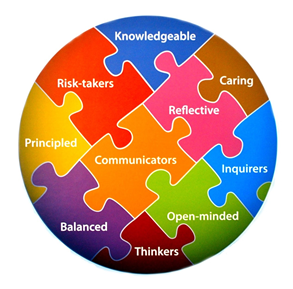 The Learner Profile can be considered the IB Mission Statement “in practice”. It:
The Learner Profile can be considered the IB Mission Statement “in practice”. It:
- embodies the attributes of a true learner
- describes an international-minded world citizen
- represents the attributes and habits required for a person to be successful in our exponentially changing new world.
Why is the IB Learner Profile one of our Core Beliefs, and embedded into all that we think, say, and do at CIS? Well, it:
- describes the attributes of the type of learner CIS strives to develop
- embeds empathy toward others who may have differing world views to us
- prepares students to be successful in our rapidly changing world.
While the Learner Profile outlines the desired attributes of our students (and all community members too!), the Approaches to Learning (ALT) help students (and adults) “learn how to learn” and are transferable across curriculums and into their personal life. The good news is we do not have a fixed intelligence, so all of us can continue to develop these skills.
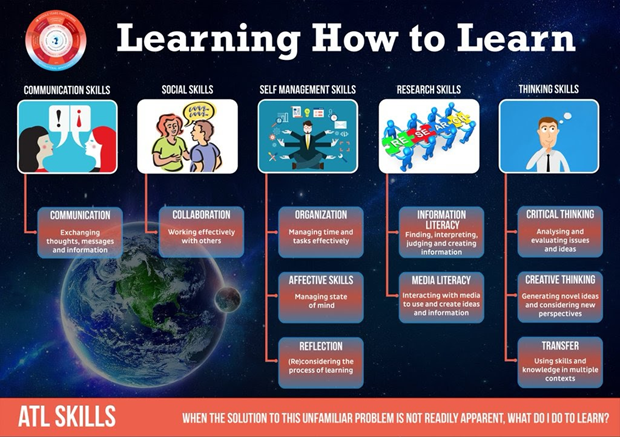
To conclude, let’s come back to the question, “How can we learn to get on better?”. A proven option is to value and nurture the LP attributes we hold dear, and actively develop our skills so we can learn how to learn better (ATL). The first two skill clusters of Communication and Collaboration will be a good start to explore. Just use the internet to explore the many resources available about these two areas. Or you can ask CIS Students – they are all developing their ATL skills at every grade level and it will be good for them to explain the areas, and you can discuss it together!
Celebration of the Week
by Ms. Jenny Basa, College/Careers Counselor
Congratulations to Chynna, Lorenzo, Naoki, and Hyeonjun of Grade 11! They joined a Design challenge after completing a two-week Engineering Taster Programme sponsored by TEDI-London.
Here is an excerpt from the letter awarded to the team. “Sofia^4’s impressive final submission was selected as the joint winner for ‘Best Engineered Solution’. The project successfully applied research into colour and light theory and incorporated sustainable elements to create an immersive structure to support users with visual impairments. The judging panel were especially impressed with the team-work demonstrated by Sofia^4 and their confident delivery and coordination during the presentation.”
Congratulations team!!! Your CIS family is proud of your achievement!
Dates for your attention: Refer to our online School Calendar a complete listing of school events.
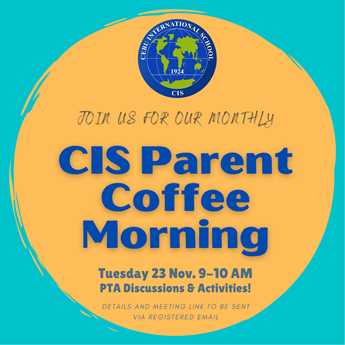
Grade 2 Class: Global Citizens
by Ms. Marina Ocleasa, Grade 2 Teacher
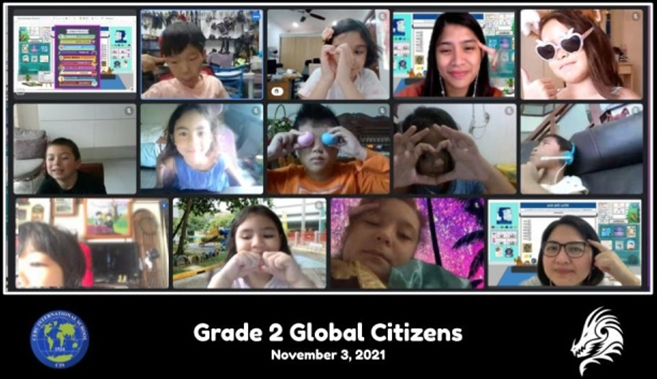 The Grade 2 Global citizens have been inquiring into how multiple perspectives help global citizens respect similarities and differences. Last week, they engaged in a meaningful collaborative discussion about what it means to be a global citizen and internationally-minded. They realized that for an internationally-minded person to be a global citizen, one must be an inquirer, knowledgeable, communicator, thinker, open-minded, principled, risk-taker, caring, balanced, and reflective. These are the very same attributes that IB students strive to become. The Grade 2s shared their perspectives on what they think is the most important attribute or trait that a global citizen should have. They shared their opinion during our Writer’s Workshop using
The Grade 2 Global citizens have been inquiring into how multiple perspectives help global citizens respect similarities and differences. Last week, they engaged in a meaningful collaborative discussion about what it means to be a global citizen and internationally-minded. They realized that for an internationally-minded person to be a global citizen, one must be an inquirer, knowledgeable, communicator, thinker, open-minded, principled, risk-taker, caring, balanced, and reflective. These are the very same attributes that IB students strive to become. The Grade 2s shared their perspectives on what they think is the most important attribute or trait that a global citizen should have. They shared their opinion during our Writer’s Workshop using 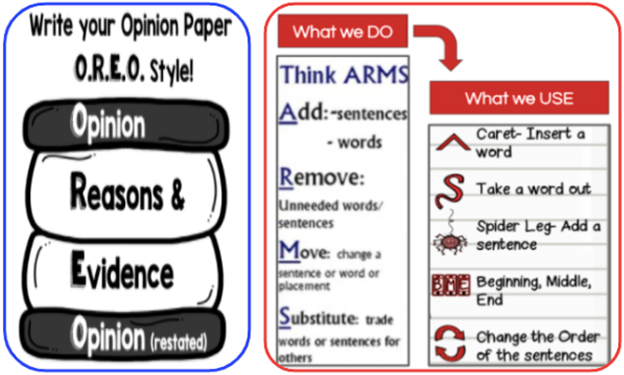 the O.R.E.O. (Opinion, Reason, Evidence, Opinion restated) as a guide to organize their opinion pieces. Then, they looked at how they can improve their writing using A.R.M.S. (Add, Revise, Move, Substitute) to revise. We saw how our Grade 2 Writers revised and improved their writing pieces by responding and applying the feedback given by their teachers and classmates.
the O.R.E.O. (Opinion, Reason, Evidence, Opinion restated) as a guide to organize their opinion pieces. Then, they looked at how they can improve their writing using A.R.M.S. (Add, Revise, Move, Substitute) to revise. We saw how our Grade 2 Writers revised and improved their writing pieces by responding and applying the feedback given by their teachers and classmates.
Here are some of the opinion pieces the Grade 2s wrote.
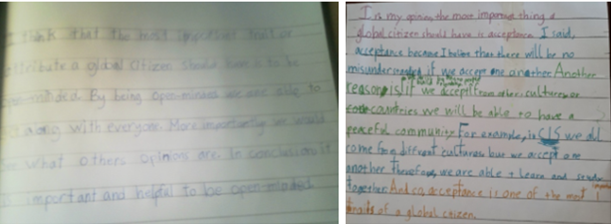
I think that the most important trait or attribute a global citizen should have is to be open minded. By being open minded we are able to get along with everyone. More importantly, we would see what others’ opinions are. In conclusion, it is important and helpful to be open-minded. – Fiona
In my opinion, the most important thing a global citizen should have is acceptance. I said acceptance because I believe that there will be no misunderstanding if we accept one another. Another reason is if we accept people from other cultures or countries, we will be able to have a peaceful community. For example, in CIS we all come from different cultures but we accept one another. Therefore, we are able to learn and study together. And so, acceptance is one of the most important traits of a global citizen. – Erin
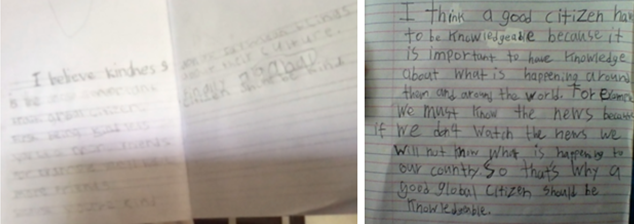
The most important trait of a global citizen is communicator. First, we can explain something properly. For example, when we go to a restaurant, we need to say that we use forks instead of chopsticks. Another reason is communication skills will help us understand each other. An example of this is, I can speak very well, I can use my body language and gestures to make other people understand. In conclusion, communication is the most important thing that a global citizen should have. – Joon
I believe kindness is the most important trait a global citizen should have. First, being kind lets you have more friends. For instance, you’ll have more friends if you are kind and don’t say mean things about others’ cultures. Finally, a global citizen should be kind. – Elise
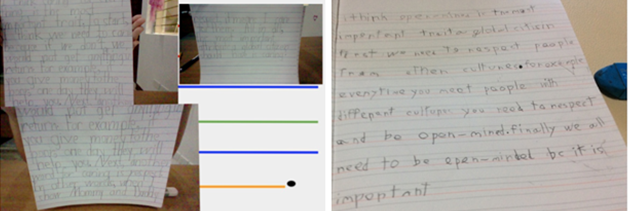
How about you? What do you think is the most important attribute a global citizen should have? Why?
Grade 11: Visual Arts Class
by Ms. Gerri Ancajas Jumao-as, Visual Arts Teacher
This year we welcome the next promising artists of Grade 11 Visual Arts class. While their works are diverse in both theme and technique, they all have fresh approaches and limitless possibilities ahead of them as they pursue the IB DP Visual Arts course.
2D Drawing
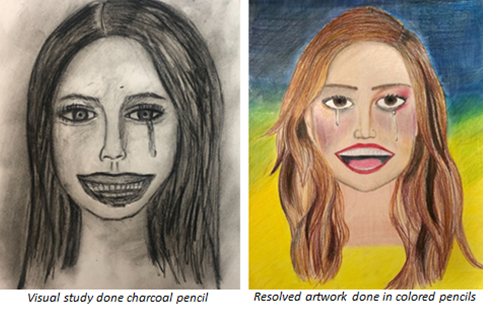 In this first piece of artwork, I especially wanted to focus on human feeling and emotions. This is because it is the type of emotion I know the most and have experienced a lot as a human being. I think happiness and sadness is the most common emotion people feel. People easily get excited and joyful with simple things, but they even get depressed and annoyed as easily as they feel happy. So, to express these two most common human emotions, I used two different facial expressions at once, eyes crying but mouth laughing. The two facial expressions, her mouth smiling and eyes crying shows her confusion in her own feelings and thoughts. – Yoonseo
In this first piece of artwork, I especially wanted to focus on human feeling and emotions. This is because it is the type of emotion I know the most and have experienced a lot as a human being. I think happiness and sadness is the most common emotion people feel. People easily get excited and joyful with simple things, but they even get depressed and annoyed as easily as they feel happy. So, to express these two most common human emotions, I used two different facial expressions at once, eyes crying but mouth laughing. The two facial expressions, her mouth smiling and eyes crying shows her confusion in her own feelings and thoughts. – Yoonseo
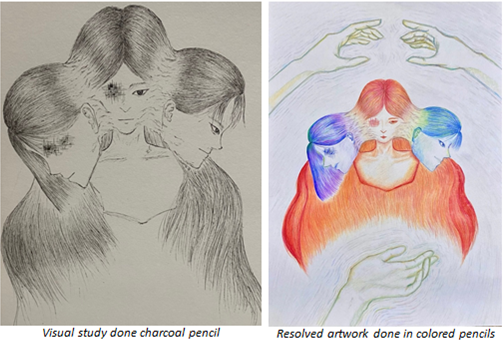 These two sketches are about my appearance, especially related to my hairstyle. When I said that I was going to have a short haircut, there were a lot of contradictions about having short hair and even some gave me bad looks. The message I want to express is that the length of my hair doesn’t change my personality. To represent the social pressure and pressure from surroundings, I decided to add hands on the second sketch. I drew hands to represent the collection of broken pieces from the head to express the stress. – Chewon
These two sketches are about my appearance, especially related to my hairstyle. When I said that I was going to have a short haircut, there were a lot of contradictions about having short hair and even some gave me bad looks. The message I want to express is that the length of my hair doesn’t change my personality. To represent the social pressure and pressure from surroundings, I decided to add hands on the second sketch. I drew hands to represent the collection of broken pieces from the head to express the stress. – Chewon
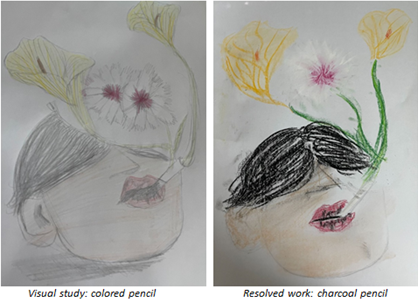
I drew a man smoking a cigarette. Instead of cigarette smoke, I drew flowers. The concept is to show a man who is depressed so he smokes. The flowers growing out of the cigarette means that after happiness comes misery, since flowers can symbolize a happy life. – Yongwoo
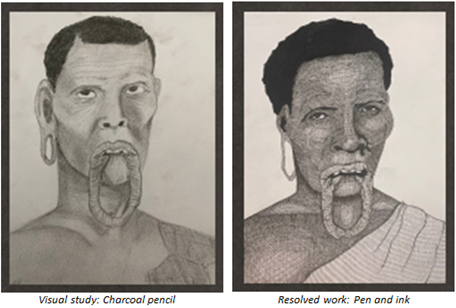
The portrait I plan to draw displays a woman from either the Mursi or Suri tribe without her lip plate on. The lip plate is a symbol of female maturity in these tribes. I interpret this practice as a symbol of women’s strength and what they have to give up in order to survive in society. I wanted to illustrate strength by revealing the scars that the lip plate has left on the subject’s lips. – Mikyla
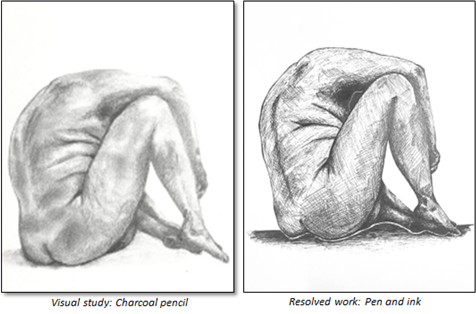
I chose to create a figurative study from a reference photo I chose. In the reference photo, you can observe a nude person hiding their face away from the audience. I believe that this is a symbolism for fear within courage. I believe that the pose represents confidence but due to societal standards, insecurities can interfere. I believe that courage is present in this because it takes a lot of courage to pose nude. – Naoki
2D Painting
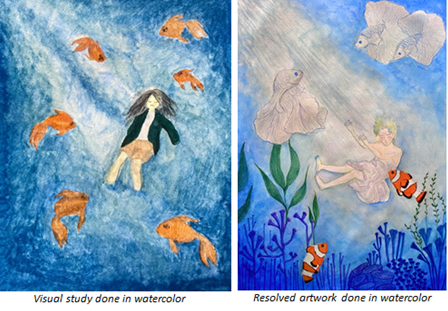
The main element of this design is a person drowning in a fishbowl. I designed this because I wanted to represent water in the fishbowl as a field of education. The person is closing her eyes to represent avoiding because I want to do hobbies while studying but I don’t have enough time for it. – Chewon
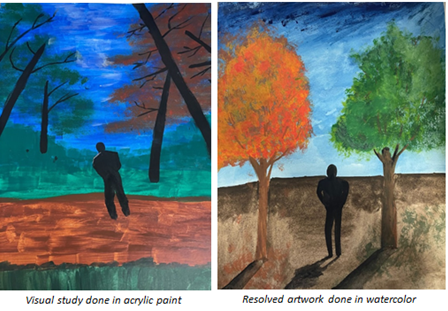
The concept of this drawing time and hesitation. I drew trees with a man standing in the middle. The left tree will be colored in green to represent summer and the right side will be in orange to represent autumn. These different colors will represent how fast time goes, while the man is still hesitating to move forward. The overall mood of the drawing will be dark. – Yongwoo
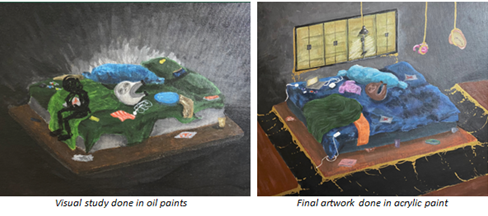
I chose to draw a still life of my room, specifically my bed because the clutter that has been building up over the weeks reflects how much stress and demotivation a person could feel. I chose this angle for this artwork because I believe it can represent an out-of-body experience where we are observing ourselves. I believe this drawing embodies the feeling of being burned out and demotivation. – Naoki
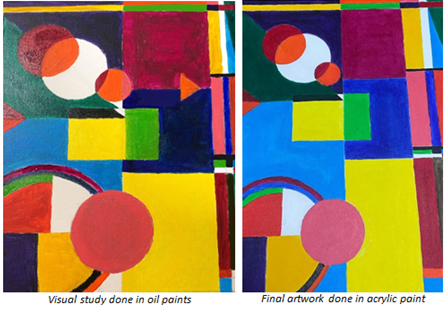
Using the different types and sized shapes, I want to express the strength and the confusion of emotions. The bright tone colors will highlight the positive emotions such as happiness and excitement, and in contrast, the dark tone colors will emphasize the negative emotions such as sadness and depression. Curved lines are used for smooth and soft feelings, while the straight lines symbolizes sharpness and direct emotions. The shapes overlap and some colors are created by mixing two different colors. This shows the variety of emotions and how all these emotions can be experienced and felt by one individual. – Yoonseo
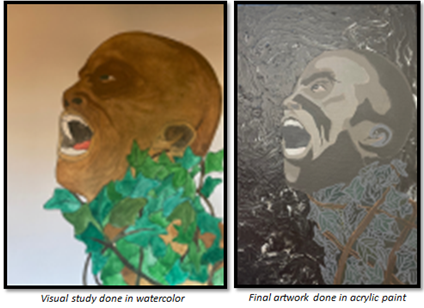
The main concept of my design is a person struggling to get out of the grasp of multiple ivy vines. The ivy vines surrounding the subject represent the clutch that depression can have on a person. I wanted to create a piece illustrating a person being consumed by their depression to reflect what it is like to be stuck in a dark place unsure of what to do and exhausted from bearing the heaving feeling of depression. – Mikyla
Grade 6&7: Music Class
by Ms. Marie Briones, Music Teacher
Exploring Alternative Tools and Spaces for Performances
In Unit 1 this trimester, the students looked into the different elements of music such as rhythm, pitch, melody, tone, texture and form. Particularly, the students explored how patterns and symbols found in each of these elements communicate ideas, evoke emotions and influence mood.
Having established from Unit 1 how music can translate symbols into ideas and emotions, the students then connected this inquiry into the role of art and the artist in the time of Covid-19 pandemic in Unit 2. This was done via an exploration of alternative spaces, and media and technology. From balcony performances, virtual spaces, new tools like social media to using household items (when musical instruments were not readily available), the students all came to a consensus that music can be used as a way to spread cheer and hope during a difficult time in history.
I think the role of music during a pandemic is to encourage people and give hope to people. Playing music on their balcony helps people to be in touch together since they can’t go out. Music gives a positive mood to the audience. Also the people enjoyed listening to the music since many concerts had been closed and could not go out. I also think that by playing music together, the people can confront the sad situation of COVID-19. […] slow tempo and higher pitched music gives me a feeling of happiness. Since slow tempo makes me calm. But the fast tempo makes me worried about something that’s gonna happen. Higher pitched music gives me a positive feeling but lower pitched music gives me a scary and dark mood and feeling. –Hana, G7
Art is important because it can let you breathe from all the stress and worries during the pandemic. It may also help with coping with your mental health problems and lessen your anxiety. It can also let you feel less isolated. […] Through music and art, people were able to express their emotions and feelings […] despite the cultural differences that we have, we are still able to understand one another through arts and music. –Ghea, G6
In my own words, rhythm is a pattern of music that everyone can create anywhere. For example, If I clap my hands 4 times, that can be a rhythmic pattern. If I clap my hands 3 times, that’s also a rhythmic pattern. You can also communicate with it. For example, if we make a slow rhythmic pattern, it might mean calm, steady and more. The person that is listening to the rhythm might have personal feelings. – Hinata, G7
Students further recognize that music and the inspiration to create is all around them, from the tiniest, most insignificant movements to the most elaborate gestures.
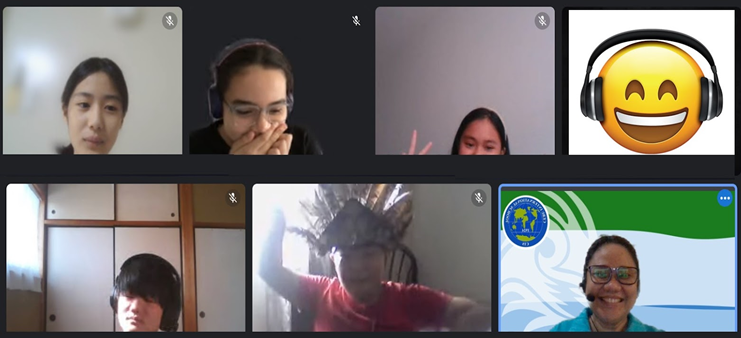
Spreading the Christmas Cheer
Since musical instruments are not readily available to some of the students, they then proceeded to assemble their own improvised, DIY instruments which they used to play a whole song. Here is a sample of a Christmas carol, the Jingle Bells, that some of the G6/7 Music played to spread cheer during the season.
Reflections for the Trimester
To wrap up the trimester, the students also shared their favorite achievements in the class, and their most significant learnings in the subject.
Savannah, G6
Leon, G7
Kuto, G6
Hinata, G7
College/Careers Counselor Corner
by Ms. Jenny Basa, College/Career Counselor
Celebration of the Week
Congratulations to Chynna, Lorenzo, Naoki, and Hyeonjun of Grade 11! They joined a Design challenge after completing a two-week Engineering Taster Programme sponsored by TEDI-London.
Here is an excerpt from the letter awarded to the team. “Sofia^4’s impressive final submission was selected as the joint winner for ‘Best Engineered Solution’. The project successfully applied research into colour and light theory and incorporated sustainable elements to create an immersive structure to support users with visual impairments. The judging panel were especially impressed with the team-work demonstrated by Sofia^4 and their confident delivery and coordination during the presentation.”
Congratulations team!!! Your CIS family is proud of your achievement!
Upcoming Virtual Events and Fairs: (students & parents are welcome)
DATE
November 26
Friday
6:00PM
Link to join
EVENT
SUNY Korea Information Session
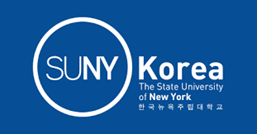
November 26 – Friday
6:00PM
Link to register
Waseda University Information Session
November 27
Saturday
11:00AM
Link to register
Career Development for International People in Japan & Business Communication
Speaker: Prof. Furukawa Tomoki
Kansai University
Target Audience: International students who wish to advance your career in Japan. Students who are living outside Japan and wishing to study in Japan.
SAT Update
The dates below indicate that registration is open. For the Dec 4 test, the school is working on requesting official permission from the government so that CIS can administer the SAT examinations.
| 2021-2022 TEST DATES* | Registration Deadline |
| August 28, 2021 | CANCELLED |
| October 2, 2021 | CANCELLED |
| December 4, 2021 | November 4, 2021 |
| March 12, 2022 | February 11, 2022 |
| May 7, 2022 | May 5, 2022 |
| *The Optional SAT Essay and Subject Tests have been discontinued. | |
To register for the SAT, you may click on this link. If you need assistance or have any questions, please feel free to email Ms. Jenny Basa at jbasa@cis.edu.ph.
Dragon’s Print
As the holiday season draws near, it is important to embrace that yuletide spirit and get in a cheerful mood. Spark the magic of your inner child with this Christmas playlist! Know more on https://dragonsprint.cis.edu.
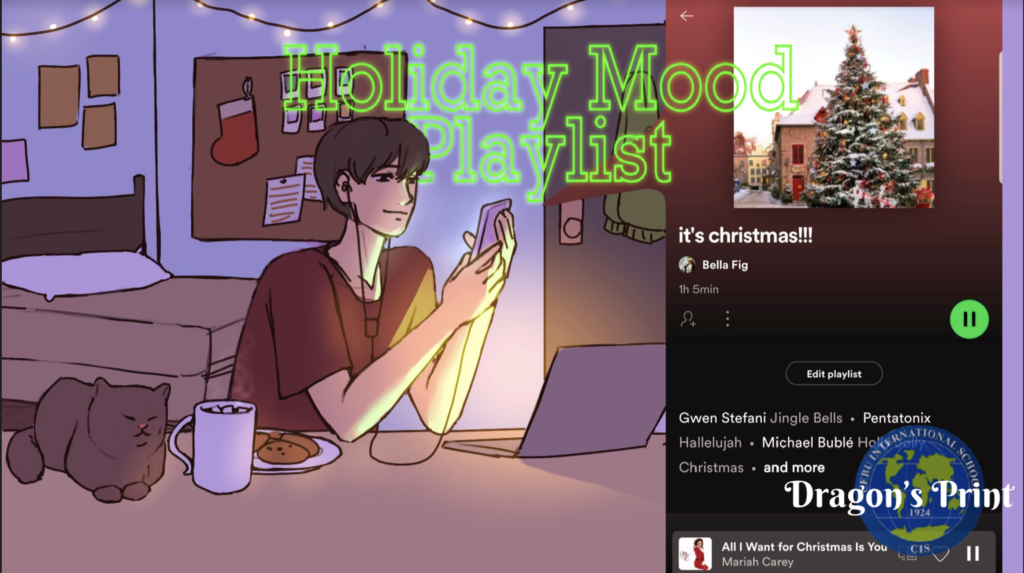



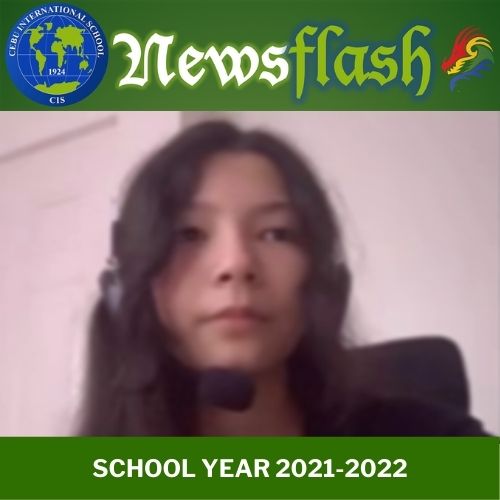
I thot mommy said I was in the newsflash 🤨